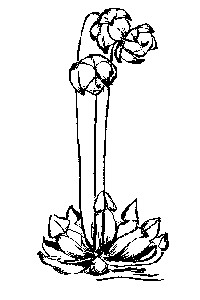
The Pitcher Plant
from Encyclopedia of Newfoundland and Labrador
This artist's rendition of the pitcher plant is also Mobilewords Limited brand mark.

The plant is one of eight species that belong to the genus Sarracenia, a name given in honour of Michel Sarrasia de L'Etang, a Quebec physician and botanist of the eighteenth century. Sarracenia pitchers grow only in North America, in wetlands such as bogs, marshes and swamps, most species growing in the southeastern United States. S. purpurea is divided into two subspecies: S. purpurea venosa, found as far north as New Jersey, and our pitcher plant, S. purpurea gibbosa, which grows from New Jersey north to Labrador.
The pitcher plant's large, solitary flower sits heavily on a long stem, its wine-red petals encasing a wine and gold centre. The pitcher-shaped leaves are attached to the bottom of the stem in a rosette, and are often partly hidden by sphagnum moss or other bog vegetation. The hollow, urn-like leaves have a reddish exterior and a green interior. All Sarracenia pitchers supplement the meagre nutrients offered in wetlands with nourishment from the bodies of insects that get trapped in the leaves. The acid bog habitat of S. purpurea is particularly deficient in nitrogen. Insects are attracted to nectar on the leaves' lips. Slippery, downward-pointing hairs inside the leaf cause many insects to slide down and drown in a pool of rain water collected in the leaf. In this pool are enzymes, and possibly bacteria, which quickly transform insects into nutrients the plant can use. Despite the enzymes, bacteria and insect skeletons that collect in the plant over a summer, explorers, missionaries and native peoples would drink the water from a pitcher plant rather than trust bog water. One popular name for S. purpurea is Indian Cup.
The plant's carnivorous or insectivorous status has led some people to proclaim it sinister, baleful or even deadly. But Darwin described such plants as being among ``the most wonderful in the world'', and several insects are actually dependant on S. purpurea. A pitcher plant mosquito lays its eggs in water inside the leaves. An Exyra moth feeds, as a caterpillar, on pitcher leaves. (The moth of S. purpurea is the only pitcher moth whose wings -- yellow, purple and wine red -- match the colours of its host plant.)
For centuries the pitcher plant has been considered to have value as a folk medicine. A number of North American native peoples are said to have made a medicine from the plant to fight smallpox. The plant has thick underground rhizomes filled with starches. The rhizomes can grow for up to 30 years, and can become a foot long. Folk medicines made from these, and from the leaves, have been used to cure menstrual, stomach, and diuretic illnesses. In 1991 many naturalists were concerned that, as their habitat was exploited by developers or damaged by pollutants, the pitcher plant may be endangered. The provincial Wildflower Society was attempting in 1991 to determine the feasibility of legislative protection of pitcher plants.